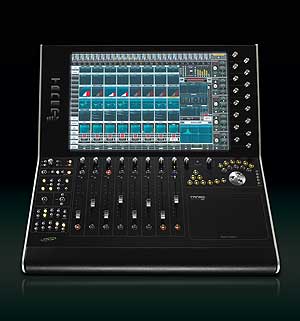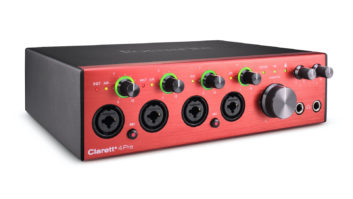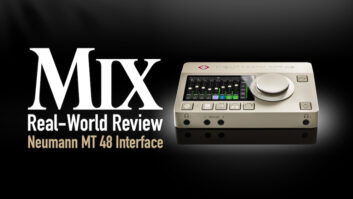
Tango allows for buttons and scroll wheels to be programmed and used in combination.
Smart AV, the designers of the original Smart Console, have created a new worksurface that aims to provide ergonomic control over your favorite DAW. The Tango’s small footprint fits into editing suites, overdub rooms, smaller mixing suites and home studios. Tango features motorized faders, a giant 22-inch touchscreen, and dozens of buttons and touch-sensitive rotary encoders that make for a comfortable user experience. Currently, there are presets for popular apps like Pro Tools, Logic and Cubase with extended support for Nuendo and Pyramix.
COMMAND AND CONTROL
The most distinctive feature of the original Smart Console was the large curved meterbridge called the ARC. This concept is replicated in Tango’s MonARC, a virtual meterbridge on the top part of the touchscreen interface. This is a clever, ergonomic way to allocate software tracks to the physical resources afforded by the control surface. You can assign any track to any fader by holding the touch-sensitive Inject button for that fader and then touching the desired track’s meter in the MonARC. Alternatively, you can choose Chair mode, which was designed to re-create the experience of sitting before a large-format console and rolling a chair from one bucket of I/Os to the next. Dragging a finger across the MonARC loads all available faders with the consecutive mixer channels surrounding the finger’s position. MonARC can be resized to reveal 27, 54 or 108 channels.
At any point in time, the desk presents eight active channel strips, each of which has a touch-sensitive motorized fader and endless rotary encoder, solo and mute. A Hold button will lock a track assignment to a channel strip, even while operating in Chair mode on the other faders. The touchscreen also has slick-looking graphics resembling a DAW’s mixer window. An input section controls the input trim on software like Nuendo, which offers input trim on each I/O strip of the Mix window. DAWs with dedicated dynamics in the mixer channel strips really shine here as Tango instantly activates these components with a press on the touchscreen.
The large, easy-to-read graphic representations of dynamics and EQ in the corner of the touchscreen mirror the smaller versions on the channel strip. DAW-specific dynamic plug-ins and any other inserted plug-ins are controllable by 16 rotary encoders—enough to control all parameters on one page for most plug-ins, although you can bank through multiple pages for more complicated plug-ins. Each encoder offers a reasonably comfortable resolution. The last control touched is also automatically mapped to the Active Encoders, a pair located in a more centralized position on the desk. One of these has a finer resolution than the ordinary encoders; the other, a motorized control, is not endless. It ranges from the lowest control value (far left) to the highest (far right), allowing quicker changes of extreme values. This proved very useful.
The channel strip also shows graphic send values and, again, these values can be changed by tapping the section, revealing larger graphics and twisting the encoders, which have mapped themselves. The output section has a pan control that blossoms into a fine-looking surround panner when surround is available. The last control value touched in any of these sections automatically maps itself to each of the individual rotary encoders for each channel strip where that control might be applicable. This way, each channel’s rotary encoder can be a panner, but as it isn’t fixed in Pan status, it becomes a more versatile control. If you adjust a headphone send on one channel, you can easily adjust that same send on other channels.
MONITORING
Although Tango has a monitor section similar to what you might find on competing products, Smart AV has taken a different approach to monitor connections. With the Tango, your interface outputs are connected directly to speakers and the routing is handled through the connected DAW. Choosing a speaker set will adjust the output routing. Adjusting the control room volume on the desk simply raises or lowers the monitor fader. The provisions for each DAW vary greatly. There are definitely advantages and disadvantages to this approach. The overall effect should be cleaner than running through additional analog circuits. Conversely, the execution is clever, though not necessarily simple. In most software, outputs are named with codes that will dictate how they will show up on the unit. Setting this up in each session I opened with Tango involved importing a preset output configuration from a template.
TOUCH ME
In addition to the role that the touchscreen plays in controlling the software mixer, full access to additional software functionality is granted through the Edit Panel. This section is completely customizable and lets you build panels of buttons to perform various functions. Each panel is a grid of rectangular buttons, eight high and eight wide. With DAWs such as Nuendo and Logic, all you have to do is pick an available soft-key, choose the function from a well-organized list, name the button and you’re set.
Each of the soft-keys can be programmed to work with the hardware scroll wheel. The same is true for any of the physical buttons on the desk. So, for example, it’s possible to set a button-plus-scroll-wheel combo to zoom in or out. In addition to pre-programmed transport buttons, a handful of open-ended hardware buttons are available in the Transport section. This is also the case in the automation-enable section. With all of these conveniently accessible, customizable controls, if you are comfortable with the Tango, you could conceivably operate a DAW without any need for an actual QWERTY keyboard. In the short amount of time I’ve spent with the Tango, I see the potential for this to be a realistic option. A mouse, however, remains necessary for some tasks, so a mouse pad is provided on the controller surface.
LEARNING TO TANGO
Using Tango’s Version 2.4 Netsmart software, the networked relationship of the unit to the software is automatically established. However, occasional hiccups occurred when switching between DAWs or when the host machine went to sleep and stopped sending messages to Tango.
While testing Tango across a number of platforms, the benefits experienced were largely DAW-specific. Smart AV must work within the limitations imposed by the control surface protocols associated with each app. For example, with Pro Tools, a plug-in already inserted on a channel can be accessed and manipulated, but only eight parameters can be controlled and no plug-ins can be instantiated from Tango itself. With Logic, only the stock EQ and dynamics plug-ins can be instantiated, but all plug-ins can be controlled to the fullest extent of their parameters. Similar limitations arose when dealing with sends. Again, these are not faults of Tango, but merely a shortcoming of these DAWs’ control surface languages. With Nuendo or Pyramix, full insert assign and control functionality are available. Sends work just as they are supposed to and integration is much slicker than with other DAWs.
I spent the most time working with Logic and found that Tango seemed to work particularly well with that platform. Once I created Edit Panel buttons for some of my standard operations and programmed some of the transport buttons for additional zoom functions, it was really easy to get lost in a mix. I can’t imagine a solution for mapping tracks to faders that’s more intuitive than the MonARC. Popping in EQs and compressors and tweaking settings was simple and natural. Using the automation-enable buttons and sweeping my finger across the MonARC, multiple tracks could change to write status instantly. The faders wrote smooth, accurate volume rides, even with multiple faders moving in a Write status. This is not always the case when it comes to hardware controllers.
Navigating through tracks, making edits and creating fades became simple with a combination of soft-keys and the scroll wheel. Once I got comfortable mapping these controls in Logic where you just pull the command from a list, I ventured back to Pro Tools. Here, programming is a breeze if you know your keyboard shortcuts. This led to some convenient sound effects editing. Creating sync points, trimming regions and drawing fades could all be easily performed with the proper keyboard combinations. Navigating through a movie clip using the scroll wheel was very convenient. And when it came time to snap a region to the insertion cursor, having the mouse right on hand was perfect.
SHOULD YOU DANCE?
Tango is well thought out. Anything that could make the use of each DAW more convenient was considered and implemented to the fullest extent available through existing machine control protocols. And it seems Smart AV is making an ongoing effort to improve the support for each specific piece of software. The company is working with DAW developers to improve their control surface protocols. In addition, Smart AV listens to user feedback and suggestions. At present, Tango is impressive-looking and enjoyable to use. There are some glitches in operation, however. Also, some users might be turned off by the high price tag for a control surface with no analog circuits. There are no mic pre’s, no analog monitoring section, no summing amps—it’s only a software controller. That said, Tango is one of the more practical software controllers I’ve come across, particularly when paired with the right piece of software.
Brandon Hickey is an independent engineer and film audio consultant.

Click on the Product Summary box to view the Smart AV Tango product page.







